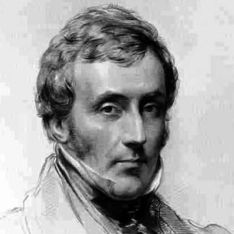
Biography
William Pulteney Alison was born at Boroughmuirhead near Edinburgh on 12 November 1790 to Archibald Alison, head of the Episcopal congregation in Edinburgh and noted author, and Dorothea Gregory, the daughter of a member of a leading literary and academic family in Scotland. Alison’s early education was private before entering the University of Edinburgh in 1803. There he studied art before shifting his focus to medicine. He achieved his MD in 1811 with a dissertation titled De viribus naturae medicatricibus.
As a student, Alison became an advocate of the teachings of Dugald Stewart, professor of moral philosophy at Edinburgh. Alison studied metaphysics and was a strong supporter of Scottish philosophy for the rest of his life.
In 1815, Alison was appointed physician to the recently established New Town Dispensary. This experience and his subsequent appointment at the Royal Infirmary brought Alison into contact with the poorest sectors of society where he witnessed first-hand squalor and deprivation. Alison published quarterly reports in the Edinburgh Medical Journal on outbreaks of epidemics throughout Edinburgh. Alison’s academic career started in 1820 when he was appointed to the Regius Chair of Medical Jurispudence. Two years later he was appointed Chair in the Institutes of Medicine, a position he held until 1842.
His lectures were summarised in two publications, Outlines of Physiology (1831) and Outlines of Physiology and Pathology (1833). One thing Alison taught his students was ‘the peculiar value of observations made on large and organised bodies of men as in the experience of military and naval practice’ – what we would today call statistics. His recognition of the value of statistics is also evident in his recommendation for better death certification.
On 6 September 1832, Alison married his first cousin Margaret Crawford Gregory. Their marriage was childless. In 1842, Alison reached the pinnacle of his academic career when he was appointed Chair of the Practice of Medicine. Alison’s principal focus for his teaching was on the science of physiology. His lectures were published in 1831 as Outlines of Physiology and expanded in subsequent editions to Outlines of Physiology and Pathology.
During the latter part of his career, Alison focused on the relationship between poverty and disease. Alison maintained that there was a strong correlation between poverty and the virulence of outbreaks of fever in Edinburgh. In his 1840 publication Observations on the Management of the Poor in Scotland and its Effect on the Health in the Great Towns, Alison argued that the government and its agencies had a major role in the alleviation of poverty and that this undertaking should not be left to religious groups or private charities. He advocated using public taxes to help the unemployed poor and criticised the establishment for ignoring those who were fit but impoverished. The Poor Law Commissioners challenged Alison to prove his claim that ‘filth without destitution was safer than destitution without filth’. However, the findings of the 1844 Royal Commission on Poor Laws (Scotland) lent support to Alison’s viewpoint.
Basing his arguments on statistics and clinical experience with Edinburgh’s poor and underprivileged, Alison won. He was able to convince the lawmakers that health and socio-economic matters cannot be separated, and in so doing challenged his students and medical colleagues to keep under review the ever-changing boundaries and goals of medicine. By 1845 much of what he had proposed had passed into statute.
Between 1855 and 1856 Alison suffered epileptic fits and remained unwell for the remainder of his life. Due to ill health, Alison resigned from his positions as chair and withdrew from private practice. Alison spent the remainder of his life at a retreat at Woodville near Colinton, where he died on 22 September 1859. His views on physiology were very popular during his lifetime, but quickly became outdated. Alison’s most significant contribution was arguably his work on public health.
Notable Achievements
Alison was president of the Royal College of Physicians of Edinburgh from 1836 to 1838.
From 1841 to 1855 Alison was Chair of Medicine at the University of Edinburgh.
In 1845, Alison was appointed first Physician to the Queen in Scotland.
Key Publications
- De viribus naturae medicatricibus (1811)
- Heads of Lectures on the Institutes of Medicine (1828)
- Outlines of Physiology (1831)
- Outlines of Physiology and Pathology (1833)
- Outlines of Human Physiology (1839)
- Observations on the Management of the Poor in Scotland (1840)
- Observations on the Epidemic Fever of MDCCCXL III in Scotland (1844)
- Observations on the Epidemic Fever (1844)



